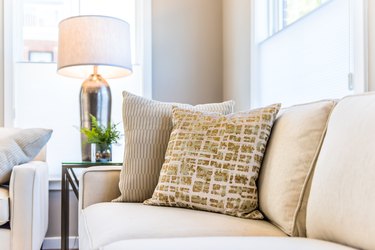
Light is light, right? Or is there a difference between your light sources whether you turn on your cellphone flashlight, light a candle, use a fluorescent bulb or just open the blinds to let in sunlight? As it turns out, there are some major differences between natural and artificial sources of light.
Natural Light Vs. Artificial Light
Video of the Day
The biggest difference between natural and artificial light is the fact that natural sources of light can be found in nature and aren't electronic. That means firelight meets the scientific-based natural light definition even though we have more control over the duration and amount of light we get through a fireplace or candle than we do from sunlight.
Video of the Day
That being said, you still have far less control over the intensity of light from all natural sources, including firelight, than you do from artificial sources like lamps since you can easily use a dimmer switch or a lower wattage bulb to reduce the light's brightness. In general, artificial light sources allow full control of intensity, duration and amount of light.
Importance of Lighting Color
Aside from the source itself and the ability to control the light's intensity and duration, natural and man-made light vary in the colors of light they emit. Sunlight emits all colors of the rainbow, including plenty of blue, which results in the light appearing white throughout most of the day. In the morning and evening, the sunlight must pass through more layers, scattering the light and resulting in more red and orange light getting through. Firelight is almost always higher in reds and oranges than blues.
On the other hand, the majority of artificial light doesn't have a rainbow of colors and always stays the same throughout the day. LED and fluorescent lights tend to have a lot of blue or yellow light (depending on if they're designed to be cool white or warm white) and not very much red. Incandescent lights, on the other hand, have a lot of red and very little blue.
Lighting and Your Health
The color of your light isn't just a matter of aesthetic preference — it actually can affect your health and sleep patterns. In fact, in climates with minimal sun exposure during the winter months, many people suffer from Seasonal Affective Disorder (SAD), a form of depression related to too little sun exposure. One of the treatments of SAD is a specialized full-spectrum (meaning it has all colors) fluorescent light box, which can help mimic natural sunlight and trick the mind and body into feeling better.
Artificial lighting can affect your sleep patterns too, which makes sense since humans have evolved so our circadian rhythms match up to the sun. This means we need plenty of blue light to make us feel awake during the day and minimal blue light at night to help us produce melatonin, which we need to feel sleepy. Unfortunately, incandescent lights leave us feeling sluggish during the day because they don't have enough blue light, and fluorescent and LED lights (as well as the light from our phone, computer and TV screens ) all have too much blue light, which keeps us up at night.
Finally, natural light helps our bodies produce vitamin D, something we need in order to properly absorb calcium. Those who don't produce vitamin D naturally due to insufficient sun exposure may need to take supplements or risk diseases related to too little calcium intake, like osteoporosis.
Plants and Artificial Light
Plants use light as food, so it makes sense that the type of light can affect how a plant grows. In fact, most plants require full-spectrum light like the sun in order to properly grow, as different colors of light can help with different aspects of a plant's growth. For example, most plants need blue and red light in order to flower. Some house plants can grow fine under ordinary artificial lights, but most plants will need a full-spectrum artificial light if they're denied actual sunlight.
- Science Daily: What Determines Sky's Colors At Sunrise And Sunset?
- Any Lamp: Natural Light vs Artificial Light
- Sunlight Inside: Natural Vs. Artificial Light
- Enotes: What Is The Difference Between Artificial Light And Natural Light?
- Light Therapy Products: Seasonal Affective Disorder (SAD) Information